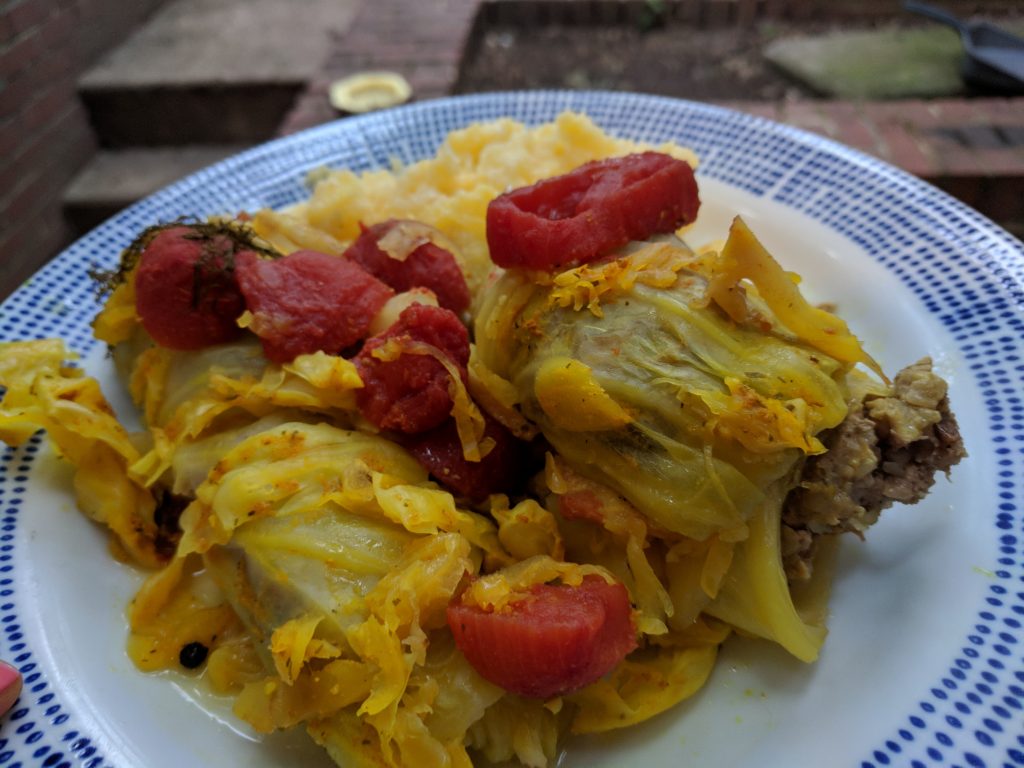Hello ladies and gents this is the Viking telling you that today we are talking about
Sarmale cu mamaliga
ROMANIA
Sarmale is a stuffed cabbage roll. Mamaliga is a type of polenta, served on top or next to sarmale. It is a main dish which is usually cooked for special events, such as Christmas, New Year’s Eve or any other family gathering.
Ingredients
- 1 large head (~4 lbs) green cabbage
FOR THE FILLING
- 2 tbsp olive oil
- 1 medium yellow onion
- 4 cloves garlic
- 3 tbsp raw rice
- 1/2 cup hot water
- 1 lb ground pork
- 1 slice bread
- 2 tbsp fresh dill
- 1 tsp fresh thyme
- 1 tsp salt
- 1 tsp black pepper
- 1 tsp red chili flakes
- 2 tbsp water
FOR THE DUTCH OVEN
- 3 cups sauerkraut
- 6 strips bacon
- 5 sprigs fresh dill
- 28 oz canned whole tomatoes
FOR THE COOKING LIQUID
- 1 cup sauerkraut juice
- 3 cups water
- 1 tsp turmeric
- 1 tsp garlic powder
- 1 tsp salt
- 10 peppercorns
- 5 bay leaves
There are many varieties of cabbage rolls popular across Eastern Europe, varying primarily by filling and sauce. You may remember, for instance, the balandeliai I made from Lithuania. Romanian sarmale aren’t all that different, although the pickled sauerkraut, bacon and dill makes it slightly more tangy and savory. This time I used pork, as called for, but reduced the amount called for in the original recipe. Despite the bacon and ground pork, this was still a fairly light dish – until you pair it with mamaliga: Romanian porridge made with yellow maize flour (a course cornmeal). Mamaliga, similar to Italian polenta, was traditionally a rural peasant staple, but can now be found in upscale restaurants. I stirred in feta, which was delightful.
While they’re time consuming they aren’t difficult. I prepared the cabbage rolls ahead of time, and then cooked them right before serving. Even so, it’s a long looking time – believe it or not the times listed below are significantly reduced from the original recipe.
Sarmale are a celebration food, traditionally served on Christmas and New Year’s Eve, weddings, baptisms, and other large celebrations. Our occasion was a dear friend who was back in town for a visit. While this recipe serves 4-5, it can easily be doubled to serve a crowd.
Steps
1.whole head in a large pot filled with boiling, salted water. Cover and cook 5 minutes, or until softened enough to pull off individual leaves. You will need about 10 leaves. When leaves are cool enough to handle, use a paring knife to cut away the thick center stem from each leaf, without cutting all the way through. Chop any remaining cabbage and set aside.
2.In a large skillet, sauté chopped onion, garlic and rice in 1 tablespoon of the olive oil, stirring frequently, until onion is translucent. Add a half cup of hot water, bring to a boil, reduce heat and simmer 10 minutes. Remove from heat, cover and let stand 5 minutes or until rice has absorbed all the water. Let cool.
3.Place pork in a large bowl. Quickly dip bread in water, squeeze to remove excess water; tear up and add to meat along with cooled onion-garlic-rice mixture, combining thoroughly. Add dill, thyme, salt, pepper, hot pepper, and 2 tablespoons water. Mix completely but lightly so as not to toughen the meat.
4.In a medium bowl, mix sauerkraut juice with 3 cups water, turmeric, garlic powder, salt, peppercorns, and bay leaves, and set aside.
5.Place about 1/2 cup of meat mixture in the center of the base of each cabbage leaf. Flip the sides into the middle, and roll away from you to encase the meat. I split the meat into portions first so I could divide evenly. Repeat with remaining rolls.
6.Briefly fry the drained sauerkraut in the pan you used for the onions to dry it out slightly. Mix reserved chopped cabbage with sauerkraut. Place 1/3 of it in the bottom of the Dutch oven. Place 3 strips bacon across sauerkraut and cover with a layer of stuffed cabbages rolls. Add another layer of sauerkraut, bacon strips and stuffed cabbage. Then top with remaining sauerkraut and pour sauerkraut juice/water mixture over all.
7.Heat oven to 375 F. Place Dutch oven over high heat on the stovetop and bring to a boil. Lower heat to medium-low, cover and simmer about 10 minutes. Transfer to oven and cook 45 minutes.
8.Then add sliced tomatoes, dill springs, cover and cook another 30 minutes. Remove lid and continue cooking another 15 minutes. Serve over rice, potatoes, or mamiliga (polenta).

Comments
Post a Comment